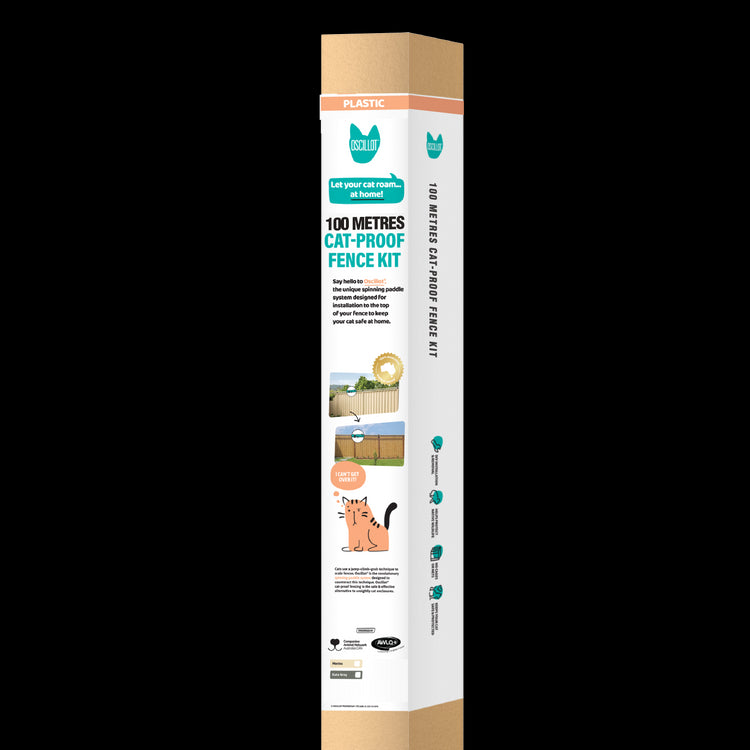5 Best Materials for Cat Proof Fencing

Keeping cats safe outdoors is important for pet owners. The right fencing materials can create a secure space for your kitty to enjoy nature without roaming freely. Let's look at the top options to keep your cat contained and happy in the yard. These materials will help your feline friend experience the outdoors safely.
Key Points for Cat-Proof Fencing Materials
- Metal/Colourbond fencing is durable and hard to climb
- High-quality plastic is versatile and weather-resistant
- Combination systems use both metal and plastic benefits
- Mesh and netting offer flexible, less visible options
- Natural materials can be eco-friendly alternatives
- Fences should be at least 1.8 meters high
- Choose materials based on your cat's behaviour
- Proper setup and care are important for long-term use
- You can customise fencing for your specific yard
- Check fences regularly to keep them working well
1. Metal/Colourbond: Strong and Effective
Metal fencing like Colourbond is great for keeping cats in. Oscillot's 50 metre DIY kit shows how metal can work well. These fences are tough and can stop even clever cats from escaping.
Metal fencing is good because:
- It lasts a long time in sun, rain, and different temperatures
- Cats find it hard to climb or chew through
- It can fit different yard shapes
- Cats can't see through it, so they're less tempted to escape
- It stays in place during strong winds
The Oscillot system has rollers at the top that cats can't grip. This stops them from climbing over. Even athletic cats learn quickly that they can't get over these fences.
2. High-Quality Plastic: Flexible and Weather-Tough
Plastic fencing is light but strong. Oscillot's 160 metre plastic kit shows how plastic can work well for cat fences. It's easy to put up and lasts a long time.
Plastic fencing is good because:
- It's light and easy to install
- It doesn't rust
- It can be made in different shapes
- It often costs less than metal
- It's easy to take care of
Plastic fences like Oscillot are smooth, so cats can't grip them. They also don't break down in the sun. This means they work well for a long time, even in sunny places.
3. Combination Systems: Using Metal and Plastic Together
Some fences use both metal and plastic. Oscillot's 100 metre combination kit is a good example. These fences use the best parts of metal and plastic to keep cats in.
Combination systems are good because:
- Metal parts make the fence strong
- Plastic parts can bend and don't break in bad weather
- They can be made to fit different fences and yards
- They stop cats from climbing, jumping, and digging
- You can fix parts without replacing the whole fence
These fences use metal for strength and plastic to stop cats from climbing. This makes a fence that cats learn they can't escape from.
4. Mesh and Netting: Easy to See Through and Flexible
Mesh and netting can work well for cat fences too. They're good for making barriers above fences or for yards that already have fences. These materials let you see through the fence while keeping cats in.
Mesh and netting are good because:
- They're light and easy to put up
- They can fit different fence shapes
- You can see through them
- They let air through
- You can use them for balconies or patios too
When using mesh or netting, pick strong materials that won't break in the sun or rain. Make sure they're tight and well-attached so cats can't push through.
5. Natural Materials: Good for the Environment
You can use natural things to make cat fences too. These can look nice in your garden and be good for the environment. While they're not usually in systems like Oscillot, you can use them for DIY projects.
Natural materials include:
- Bamboo: Strong and looks nice
- Thick bushes: Make a natural wall cats can't get through
- Trees with rough bark: Hard for cats to climb
- Stone or brick walls: Very strong, but might need to be taller
- Living walls: Plants growing on a fence
If you use natural materials, make sure to take care of them. Trim bushes, check wood for rot, and watch how plants grow. You might want to use cat-repelling plants or smells too.
Key Considerations for Choosing Cat-Proof Fencing Materials
When picking a cat fence, think about these things:
Important Things to Think About for Cat Fences
- Fence height: at least 1.8 meters to stop jumping
- Strength to last through weather and cat activity
- Ability to work in different weather
- Easy to put up yourself or with help
- Easy to take care of
- Looks good with your yard and house
- Works with fences you already have
- Fits your budget and is worth the money
- Keeps cats in for a long time
- Safe for cats and other animals
- Follows local rules
- Stops cats from climbing and jumping
- Can work in different yard shapes
- Won't break down in the sun
- Can be changed to fit what you need
Think about how your cat acts too. Some cats try harder to escape than others. Watching your cat can help you pick the best fence.
Tips for Setting Up and Taking Care of Your Fence
After you pick your fence, setting it up right and taking care of it is important. Oscillot's installation guide can help you set up a good cat fence. Following expert advice helps make sure your fence works well for a long time.
Some tips for setting up and taking care of your fence:
- Make sure there are no gaps, especially in corners
- Check the fence often for damage, especially after storms
- Fix problems quickly to keep the fence working well
- Think about getting help to set up complex fences
- Keep things away from the fence that cats could use to jump
- Watch for digging at the bottom of the fence
- Clean the fence as the maker suggests
Following these tips and picking the right materials helps make a safe outdoor space for your cat. Regular checks and fixes help the fence work well over time.
Conclusion: Making a Safe Outdoor Space for Your Cat
Picking the best materials for a cat-proof fence is important for keeping your outdoor cat safe and happy. Whether you choose metal, plastic, or a mix, the key is to make a fence your cat can't climb over, squeeze through, or dig under. Each type of fence has good points, and the best choice depends on your cat, your yard, and where you live.
Remember, what works for one cat might not work for another. It might take some tries to find what works best for you. Understanding how your cat acts can help you choose. Watch your cat and be patient as you figure out the best way to keep them in.
By getting a good cat fence and setting it up right, you're giving your cat a safe place to explore outside. Your cat can enjoy the sun, watch birds, and get fresh air without the dangers of roaming free. This can make your cat happier and healthier.
With a good cat fence, you can relax knowing your cat is safe outside. It's good for your cat, your neighbours, and local wildlife. So check out your options and make a great outdoor space for your cat! Your cat will have fun outside for years, and you'll know you've given them a happy, healthy life.





Leave a comment